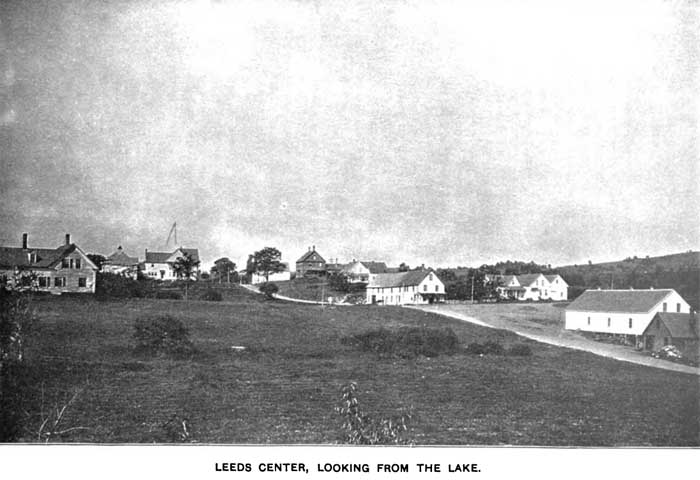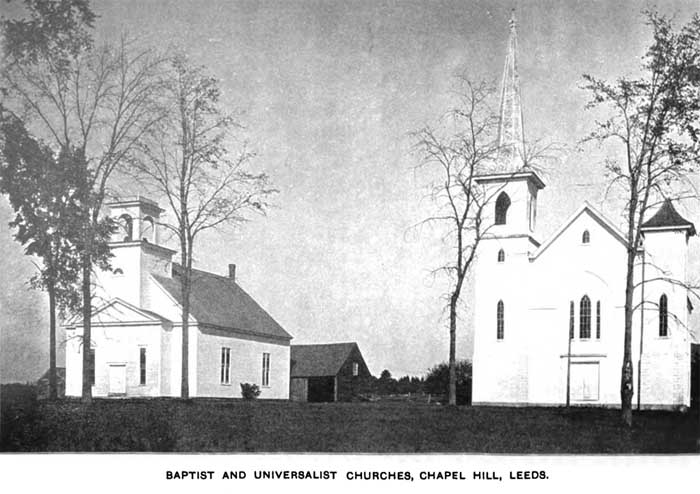|
Pg. 248 -
About the year 1790, John Jennings built the
first saw-mill, a small affair at West Leeds for the
use of himself and his three sons near him, but
accommodated his neighbors by sawing for them.
This was located near where Zachary Cary
subsequently built a fulling-mill. The second
saw-mill was built in 1804, by Thomas Mitchell
and Elias and Peter Lane. Andrew
Cushman who married Bathseba Jennings in
1789, and settled in Leeds, built the first
grist-mill, in 1814, on the privilege at West Leeds
now occupied by R. E. Swain. In 1817, he
built a saw-mill on now occupied by R. E. Swain.
In 1817, he built a saw-mill on the same power.
At his death in 1844, Daniel Hinkley
became the proprietor and built a new mill.
Stillman and Seth Howard later
owned this property. Orrin B. Taylor
was the next owner; was succeeded in turn by E.
E. Wheeler, Rodolphus Jennings and
R. E. Swain. Mr. Swain is the
present proprietor of this water-power and has a
manufactory of box boards and dowels, which
furnishes employment to several persons.
Eben Mason built the second grist- mill
in town in 1816, on the same stream, deriving power
from an overshot wheel 16 feet in diameter.
Like most of the early mills this had a short
existence. This Eben Mason was
the first blacksmith in Leeds. His shop was at
the corner near where R. S. Loring, M.D. now
resides. Oliver P. Frost was an early
blacksmith in the town and had his shop at West
Leeds. Charles Bates was another early
engaged in that business, and was located on Quaker
Ridge, or Bates Hill, which takes its name from him.
At Leeds Center, Robert Crumett was the first
blacksmith. Stephen Welcome and
Cyrus Sampson had "asheries," where
they made potash. The trades of tanning and
shoemaking were early combined. Samuel
More, who served in the Navy in the War of
1812 and was made prisoner, came to Leeds in 1814,
put up a small tannery at Leeds Center and was the
town's first tanner. He continued to tan
leather and make shoes until 1849. In 1881 he
died. Other tanners were James and Ira Lamb
and Seth Cary.
MERCHANTS.
The first
merchant in town was Thomas Stinchfield, who
had an extensive Indian trade. Some of the
early, wealthier settlers kept large stocks of
necessities for their own use, and frequently

LEEDS CENTER, LOOKING FROM THE LAKE.
Pg. 249 -
accommodated their neighbors by sales or barter.
The first regular storekeepers, as we now use the
term, were Solomon Lothrop, at the
Center; Stephen Welcome, in the
southwest part; William Turner, in the
south part and Cyrus Sampson at South
Leeds; while later, Stephen Day
(1839), and Joshua Lane (at Dr.
Lorings's Corner) had good stores.
Solomon Lothrop established at Leeds
Center in 1820, and was in trade many years.
He was succeeded by Noah Sturtevant,
of Winthrop, who continued in trade until the store
was burned. It was rebuilt by Mr.
Lothrop who again engaged in trade. He was
succeeded by Barnabas Davee, who
conducted in connection therewith a furniture shop,
and for several years did a thriving business.
About 1822, Simeon Foss was in trade
on the southeast corner at Leeds Center, and
Nathan Randall near the town-house.
Mr. Davee's successor was a Mr.
Fogg, who was in business but a short time
when the store remained closed for several years.
It was again utilized by Mr. Lothrop
and his son, Solomon L., but in 1846, they
sold out to Thaddeus More, who in turn, sold in 1847
to Josiah Day. From 1849 to 1853, the
railroad contractors run a store at the Center.
In 1861, G. C. More, a brother of Thaddeus
was in trade in the Lothrop store. After him
came Cyrus B. Lane. In 1872, Charles
H. Lane was there engaged in business. His
successor was W. L. Francis, who has made
extensive repairs and annexes and since continued in
trade at the old stand, carrying a large general
stock of goods and doing a thriving and prosperous
business. He has long been postmaster and
discharged the duties of the office to the
satisfaction of the patrons. At Keen's
Corner a store was quite early established.
In 1824, John Keene, who then and for
many years after run this store, was licensed to
sell spirituous liquors. With the coming of
the railroad, stores were established at Curtis
Corner and North Leeds. With the
improved advantages at West Leeds, a store was
opened there in 1828, by Jonas P. Lee.
His successor was Zachary Cary who
continued in business from 1830 to 1837, when he
sold to Silas Morse, and in 1840 the
store was converted into a blacksmith shop. On
the site where the buildings of H. W. Lincoln
were recently burned, a store was built by
Benjamin Millett, who, after a few years, sold
to the late Stephen R. Deane. He was
engaged in trade there several years, fifteen of
which, he held the office of postmaster. His
successors were Rhodolphus Jennings,
R. E. Swain and C. H. Foster. In
a new store, Perry Grant has been
several years in trade where he is now engaged.
In 1852, T. Clarkson Foss built and opened a
store at North Leeds. He was an extensive
buyer of wool, in which business he was successful
and acquired a good property. Since his
decease, Robert Scott, Messrs. Chamberlain Bros.,
and W. C. Tribou have, in turn, done business
there. At present, the prop-
Pg. 250 -
erty is in the hands of A.
W. Manter and his wife, who are engaged in
trade. A few years subsequent to the building
of this store, Henry and Jason Woodman,
brothers, erected a store a few rods westerly of the
buildings of Mr. Foss and opened a general
stock of goods. They were a long time in
business. After the decease of Jason,
Henry returned to the farm on which he was
born and reared and continues his residence there
still. C. H. Whitehouse, a son-in-law
of Jason is the present occupant of that
store and does quite an extensive business in grain
and feed. Mr. Guy Foss, in another
place at North Leeds was engaged in trade, who was
succeeded by his mother, present occupant.
About 1850, Salmon and his son, Henry M.
Brewster, erected and opened a general store at
Curtis Corner. Much of the time since it has
been open, and until a recent date has been occupied
by a member of the Brewster family.
Gustavus W. Lane established himself in
mercantile business at the Center in 1883, and has
been a heavy dealer in groceries, flour, grain,
feed, etc. In connection with his mercantile
business, in 1889, he erected a steam grist-mill
near his store and the railroad station, the
capacity of which was 200 bushels per day. His
business was thereby increased from $5,000 to
$50,000 annually. He has also busy life.
Previous to removing from Quaker Ridge to Curtis
Corner, Salmon Brewster had been in
trade there. He was succeeded in 1851 by O.
T. Wing, who was a short time engaged in
business, but soon retired. In 1898, W. H.
Brewster leased a part of his store at Curtis
Corner to R. D. Rand & Co., dealers in
groceries, grain and feed. The present staff
of merchants in town are: W. L. Francis,
G. W. Lane, at Leeds Center; C. H. White house,
Mrs. A. W. Manter and Mrs. Vesta P. Foss,
at North Leeds; R. D. Rand & Co. , and H.
M. Brewster, at Curtis Corner; Perry Grant,
at West Leeds.

BAPTIST AND UNIVERSALIST CHURCHES, CHAPEL HILL,
LEEDS
|
![]()